Thermal Performance Analysis of an Indirect Solar Cooker Using a Graphene Oxide Nanofluid
Abstract
:1. Introduction
2. Geometrical Parameter-Based Mathematical Model of the PTC
3. Materials and Methods
3.1. System Specification
3.1.1. The Parabolic Trough Collector’s Characteristics
3.1.2. The Box Solar Cooker ‘s Specifications
3.2. Preparation of Graphene Oxide Nanosheets
3.2.1. Synthesis of Graphene Oxide (GO) Nanosheets
3.2.2. XRD Examination of GO
3.3. GO Nanofluid Preparation
3.4. System Evaluation
3.4.1. Stagnation Temperature Test (First Figure of Merit F1)
3.4.2. Estimating the Second Figure of Merit F2
3.4.3. Energy Analysis
3.4.4. Exergy Analysis
3.5. Textural Analysis
4. Results
4.1. Figures of Merits
4.2. Energy Analysis of the Cooking Unit
4.3. Exergy Analysis of the Cooking Unit
4.4. Quantities of Rice Required for a Family and Texture Analysis
5. Conclusions
- The solar cooker with the GO (500 ppm)-water nanofluid had energy and exergy efficiencies of 12.8% and 6.97%, respectively. Moreover, the solar cooker with GO (500 ppm)-water showed superior performance.
- Using the GO (250 ppm)-water and GO (500 ppm)-water nanofluids in the indirect solar cooker enhanced the average overall energy efficiency of the solar cooker by 3.3% and 4.2% compared to that of a system with water, respectively. Moreover, the corresponding enhancement in the average of the overall exergy efficiency was found to be of 4.47 and 5.1 percentage points, respectively.
Author Contributions
Funding
Institutional Review Board Statement
Informed Consent Statement
Data Availability Statement
Conflicts of Interest
Nomenclature
| PTC | Parabolic trough collector |
| x | Horizontal axis |
| y | Vertical axis |
| f | Focal length (m) |
| H | Height of the trough (m) |
| a | Aperture width (m) |
| Rim angle (in degree) | |
| Radius of the rim (m) | |
| Aperture area (m2) | |
| Outer diameter of the absorber tube (m) | |
| Length of the absorber tube (m) | |
| Length of the trough (m) | |
| Surface area (m2) | |
| Geometrical concentration ratio | |
| Input energy | |
| ULS | Heat loss factor (W/°C·m2) |
| I | Intensity of solar radiation (Wm−2) |
| Aperture area of the cooker | |
| Energy output | |
| Mass of water (kg) | |
| Specific heat of water (J/kg·°C) | |
| Final temperature of water (°C or K) | |
| Initial temperature of water (°C or K) | |
| Time period (s) | |
| Energy efficiency | |
| Input exergy | |
| Output exergy | |
| Tamb | Ambient temperature (°C or K) |
| Exergy efficiency | |
| Solar surface temperature on Earth’s surface, (K) | |
| Absorber plate temp. (°C) | |
| t1, t2 | Time to reach a certain water temperature, and in (°C) |
References
- Suman, S.; Khan, M.K.; Pathak, M. Performance enhancement of solar collectors—A review. Renew. Sustain. Energy Rev. 2015, 49, 192–210. [Google Scholar] [CrossRef]
- Saxena, A.; Varun; Pandey, S.P.; Srivastav, G. A thermodynamic review on solar box type cookers. Renew. Sustain. Energy Rev. 2011, 15, 3301–3318. [Google Scholar] [CrossRef]
- Panwar, N.L.; Kaushik, S.C.; Kothari, S. Role of renewable energy sources in environmental protection: A review. Renew. Sustain. Energy Rev. 2011, 15, 1513–1524. [Google Scholar] [CrossRef]
- Sandeep, H.M.; Arunachala, U.C. Solar parabolic trough collectors: A review on heat transfer augmentation techniques. Renew. Sustain. Energy Rev. 2017, 69, 1218–1231. [Google Scholar] [CrossRef]
- Gong, X.; Wang, F.; Wang, H.; Tan, J.; Lai, Q.; Han, H. Heat transfer enhancement analysis of tube receiver for parabolic trough solar collector with pin fin arrays inserting. Sol. Energy 2017, 144, 185–202. [Google Scholar] [CrossRef]
- Hosseinzadeh, M.; Sadeghirad, R.; Zamani, H.; Kianifar, A.; Mirzababaee, S.M.; Faezian, A. Experimental study of a nanofluid-based indirect solar cooker: Energy and exergy analyses. Sol. Energy Mater. Solar Cells 2021, 221, 110879. [Google Scholar] [CrossRef]
- Bekele, A.; Dereje, S.; Pandey, V.; Badruddin, I.A. Experimental Investigation of Parabolic Dish Solar Collector using Nanofluids for Steam Cooking. Arab. J. Sci. Eng. 2023, 49, 2581–2597. [Google Scholar] [CrossRef]
- Abd-Elhady, M.S.; Abd-Elkerim, A.N.A.; Ahmed, S.A.; Halim, M.A.; Abu-Oqual, A. Study the thermal performance of solar cookers by using metallic wires and nanographene. Renew. Energy 2020, 153, 108–116. [Google Scholar] [CrossRef]
- Oommen, R.; Jayaraman, S. Development and performance analysis of compound parabolic solar concentrators with reduced gap losses—Oversized reflector. Energy Convers. Manag. 2001, 42, 1379–1399. [Google Scholar] [CrossRef]
- Mawire, A.; McPherson, M.; Van Den Heetkamp, R.R.J. Simulated energy and exergy analyses of the charging of an oil–pebble bed thermal energy storage system for a solar cooker. Sol. Energy Mater. Sol. Cells 2008, 92, 1668–1676. [Google Scholar] [CrossRef]
- El Moussaoui, N.; Talbi, S.; Atmane, I.; Kassmi, K.; Schwarzer, K.; Chayeb, H.; Bachiri, N. Feasibility of a new design of a Parabolic Trough Solar Thermal Cooker (PSTC). Sol. Energy 2020, 201, 866–871. [Google Scholar] [CrossRef]
- Noman, M.; Wasim, A.; Ali, M.; Jahanzaib, M.; Hussain, S.; Ali, H.M.K.; Ali, H.M. An investigation of a solar cooker with parabolic trough concentrator. Case Stud. Therm. Eng. 2019, 14, 100436. [Google Scholar] [CrossRef]
- Azmi, W.H.; Sharma, K.V.; Sarma, P.K.; Mamat, R.; Anuar, S. Comparison of convective heat transfer coefficient and friction factor of TiO2 nanofluid flow in a tube with twisted tape inserts. Int. J. Therm. Sci. 2014, 81, 84–93. [Google Scholar] [CrossRef]
- Mehrali, M.; Sadeghinezhad, E.; Rosen, M.A.; Latibari, S.T.; Mehrali, M.; Metselaar, H.S.C.; Kazi, S.N. Effect of specific surface area on convective heat transfer of graphene nanoplatelet aqueous nanofluids. Exp. Therm. Fluid Sci. 2015, 68, 100–108. [Google Scholar] [CrossRef]
- Bharadwaj, G.; Sharma, K.; Pandey, A.K.; Gupta, A. Carbon nanotube–graphene-based nanofluids: A comprehensive review on the role of thermal conductivity and its solar energy applications. J. Therm. Anal. Calorim. 2024, 2024, 1–35. [Google Scholar] [CrossRef]
- Prabu, A.S.; Chithambaram, V.; Muthucumaraswamy, R.; Shanmugan, S. Experimental investigations on the performance of solar cooker using nichrome heating coil—Photovoltaic with microcontroller PIC 16F877A. Environ. Prog. Sustain. Energy 2023, 42, e14028. [Google Scholar] [CrossRef]
- Papade, C.V.; Kanase-Patil, A.B. Characterization of nano-mixed PCM for solar cooker application. Mater. Today Proc. 2023. [Google Scholar] [CrossRef]
- Subramani, J.; Nagarajan, P.K.; Wongwises, S.; El-Agouz, S.A.; Sathyamurthy, R. Experimental study on the thermal performance and heat transfer characteristics of solar parabolic trough collector using Al2O3 nanofluids. Environ. Prog. Sustain. Energy 2018, 37, 1149–1159. [Google Scholar] [CrossRef]
- Coccia, G.; Di Nicola, G.; Colla, L.; Fedele, L.; Scattolini, M. Adoption of nanofluids in low-enthalpy parabolic trough solar collectors: Numerical simulation of the yearly yield. Energy Convers. Manag. 2016, 118, 306–319. [Google Scholar] [CrossRef]
- Mwesigye, A.; Huan, Z.; Meyer, J.P. Thermodynamic optimisation of the performance of a parabolic trough receiver using synthetic oil–Al2O3 nanofluid. Appl. Energy 2015, 156, 398–412. [Google Scholar] [CrossRef]
- Bellos, E.; Tzivanidis, C.; Antonopoulos, K.A.; Gkinis, G. Thermal enhancement of solar parabolic trough collectors by using nanofluids and converging-diverging absorber tube. Renew. Energy 2016, 94, 213–222. [Google Scholar] [CrossRef]
- Farhana, K.; Kadirgama, K.; Rahman, M.M.; Ramasamy, D.; Noor, M.M.; Najafi, G.; Samykano, M.; Mahamude, A.S.F. Improvement in the performance of solar collectors with nanofluids—A state-of-the-art review. Nano-Struct. Nano-Objects 2019, 18, 100276. [Google Scholar] [CrossRef]
- Price, H.; Lu¨pfert, E.; Kearney, D.; Zarza, E.; Cohen, G.; Gee, R.; Mahoney, R. Advances in Parabolic Trough Solar Power Technology. J. Sol. Energy Eng. 2002, 124, 109–125. [Google Scholar] [CrossRef]
- Menbari, A.; Alemrajabi, A.A.; Rezaei, A. Experimental investigation of thermal performance for direct absorption solar parabolic trough collector (DASPTC) based on binary nanofluids. Exp. Therm. Fluid Sci. 2017, 80, 218–227. [Google Scholar] [CrossRef]
- Upadhyay, B.H.; Patel, A.J.; Sadasivuni, K.K.; Mistry, J.M.; Ramana, P.V.; Panchal, H.; Ponnamma, D.; Essa, F.A. Design, development and techno economic analysis of novel parabolic trough collector for low-temperature water heating applications. Case Stud. Therm. Eng. 2021, 26, 100978. [Google Scholar] [CrossRef]
- Sup, B.A.; Zainudin, M.F.; ZanariahShamsirAli, T.; Bakar, R.A.; Ming, G.L. Effect of Rim Angle to the Flux Distribution Diameter in Solar Parabolic Dish Collector. Energy Procedia 2015, 68, 45–52. [Google Scholar] [CrossRef]
- Faheem, M.; Jizhan, L.; Akram, M.W.; Khan, M.U.; Yongphet, P.; Tayyab, M.; Awais, M. Design optimization, fabrication, and performance evaluation of solar parabolic trough collector for domestic applications. Energy Sources Part A Recovery Util. Environ. Eff. 2020. [Google Scholar] [CrossRef]
- Abdulhamed, A.J.; Adam, N.M.; Ab-Kadir, M.Z.A.; Hairuddin, A.A. Review of solar parabolic-trough collector geometrical and thermal analyses, performance, and applications. Renew. Sustain. Energy Rev. 2018, 91, 822–831. [Google Scholar] [CrossRef]
- Collares-Pereira, M.; Gordon, J.M.; Rabl, A.; Winston, R. High concentration two-stage optics for parabolic trough solar collectors with tubular absorber and large rim angle. Sol. Energy 1991, 47, 457–466. [Google Scholar] [CrossRef]
- Deliani, L. Studying the Effect of Several Rice Varieties Storage with Different Levels of Sticky on Parboiling Quality; Faculty of Agricultural Technology, Bogor Agricultural University: Bogor, Indonesia, 2004. [Google Scholar]
- Zaaba, N.I.; Foo, K.L.; Hashim, U.; Tan, S.J.; Liu, W.W.; Voon, C.H. Synthesis of Graphene Oxide using Modified Hummers Method: Solvent Influence. Procedia Eng. 2017, 184, 469–477. [Google Scholar] [CrossRef]
- Syafutri, M.I.; Pratama, F.; Syaiful, F.; Faizal, A. Effects of Varieties and Cooking Methods on Physical and Chemical Characteristics of Cooked Rice. Rice Sci. 2016, 23, 282–286. [Google Scholar] [CrossRef]
- Verma, S.K.; Tiwari, A.K. Progress of nanofluid application in solar collectors: A review. Energy Convers. Manag. 2015, 100, 324–346. [Google Scholar] [CrossRef]
- Sansaniwal, S.K.; Sharma, V.; Mathur, J. Energy and exergy analyses of various typical solar energy applications: A comprehensive review. Renew. Sustain. Energy Rev. 2018, 82, 1576–1601. [Google Scholar] [CrossRef]
- Safaei, M.R.; Goshayeshi, H.R.; Chaer, I. Solar Still Efficiency Enhancement by Using Graphene Oxide/Paraffin Nano-PCM. Energies 2019, 12, 2002. [Google Scholar] [CrossRef]
- Mullick, S.C.; Kandpal, T.C.; Saxena, A.K. Thermal test procedure for box-type solar cookers. Sol. Energy 1987, 39, 353–360. [Google Scholar] [CrossRef]
- Lee, L.S.; Choi, E.J.; Kim, D.K.; Kim, C.H.; Kum, J.S.; Kim, Y.B.; Kim, E.M.; Park, J.D. Effects of cooking method on physical properties, color, and microstructural characteristics of scorched rice chips. Food Sci. Biotechnol. 2015, 24, 1673–1677. [Google Scholar] [CrossRef]
- Kumaresan, G.; Santosh, R.; Raju, G.; Velraj, R. Experimental and numerical investigation of solar flat plate cooking unit for domestic applications. Energy 2018, 157, 436–447. [Google Scholar] [CrossRef]
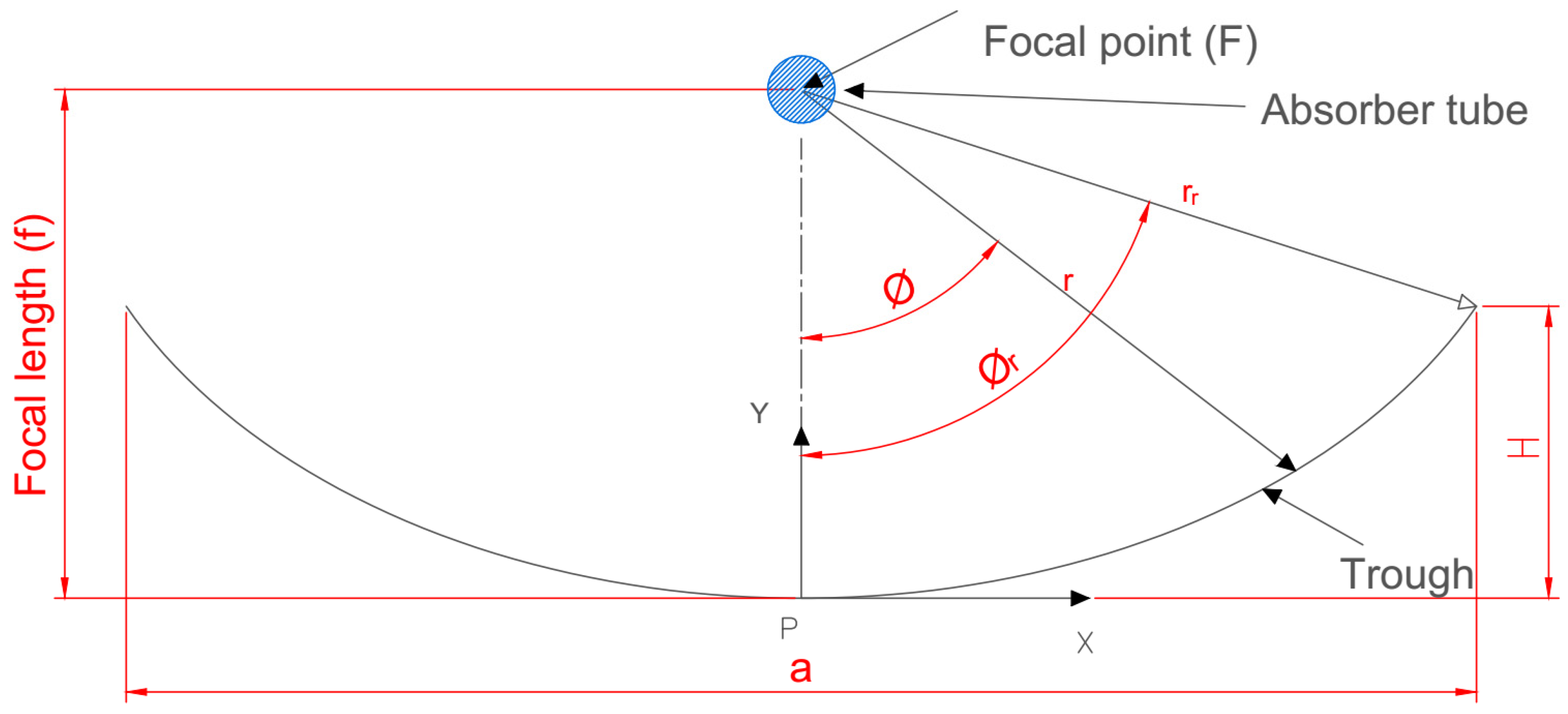

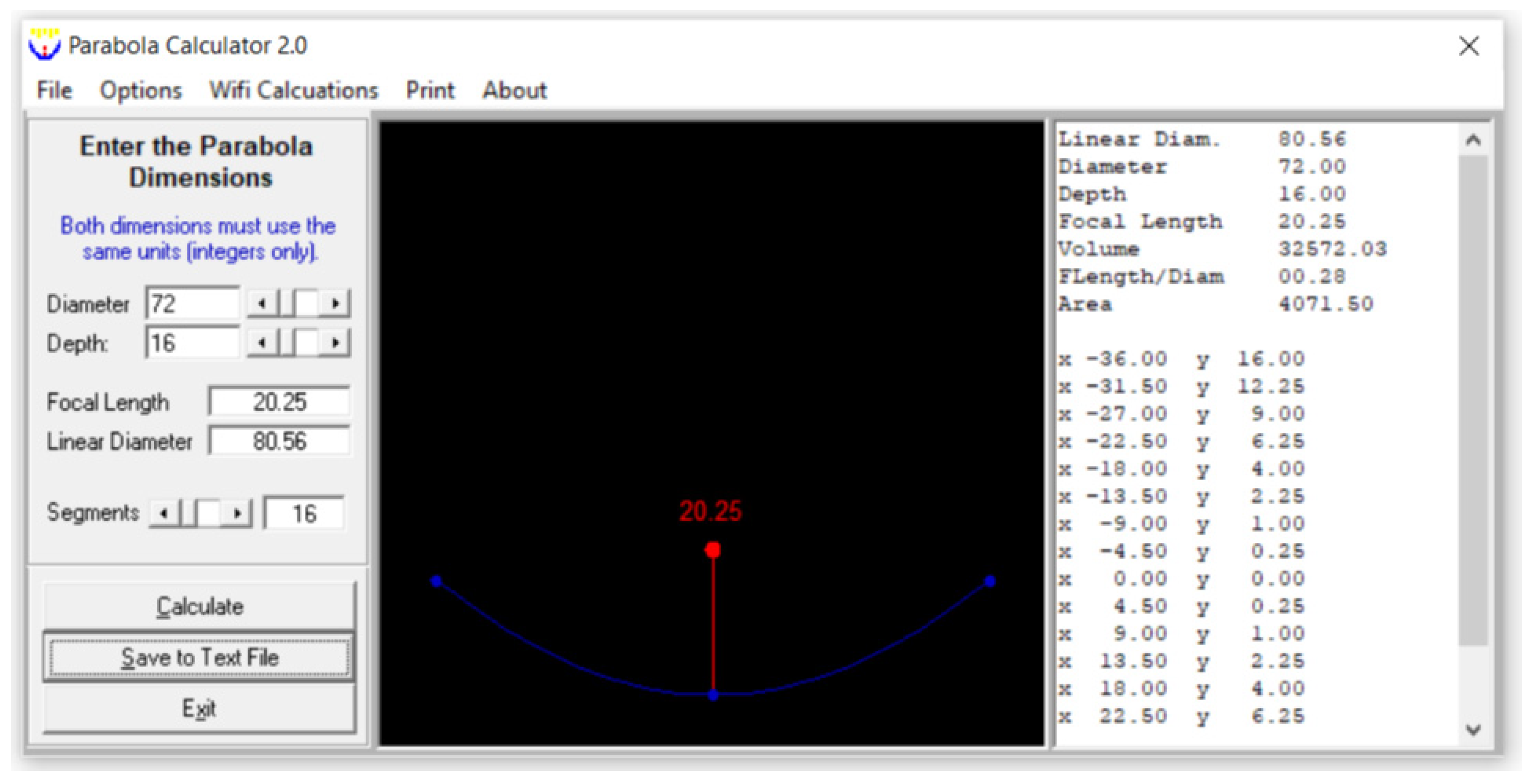



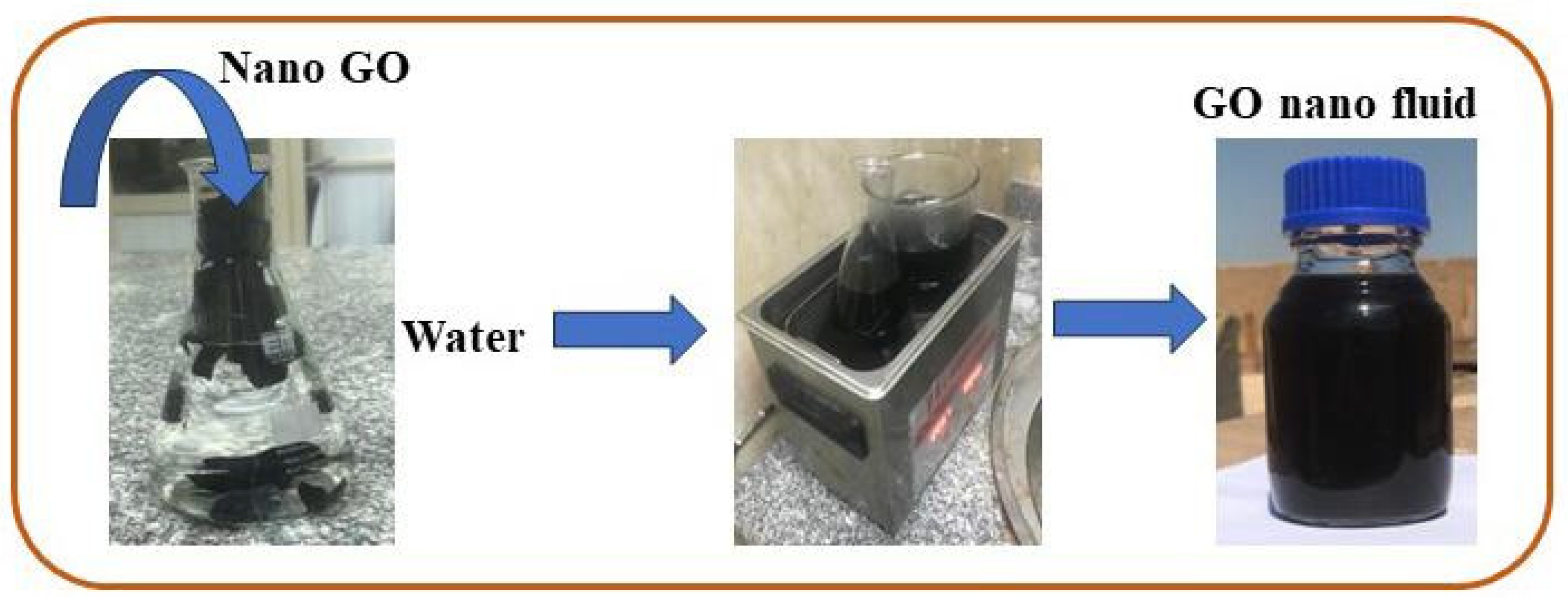
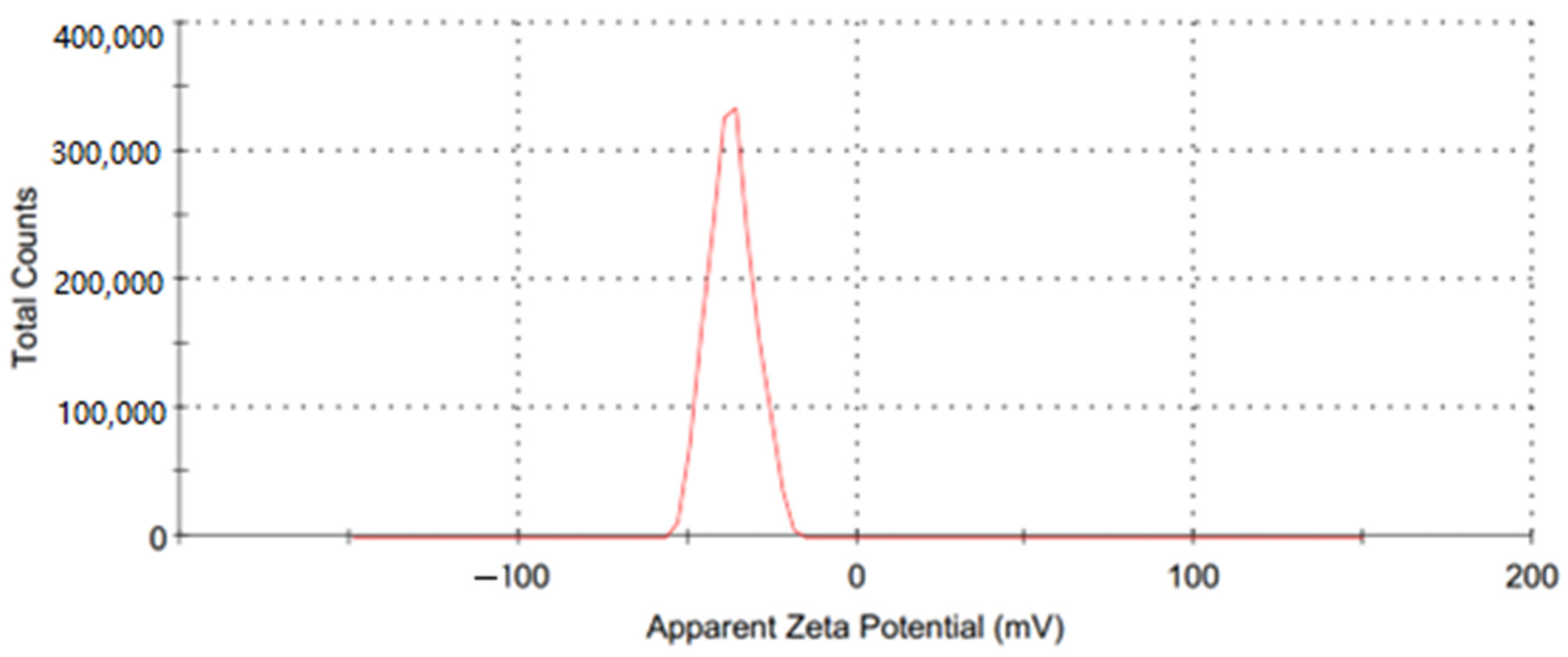

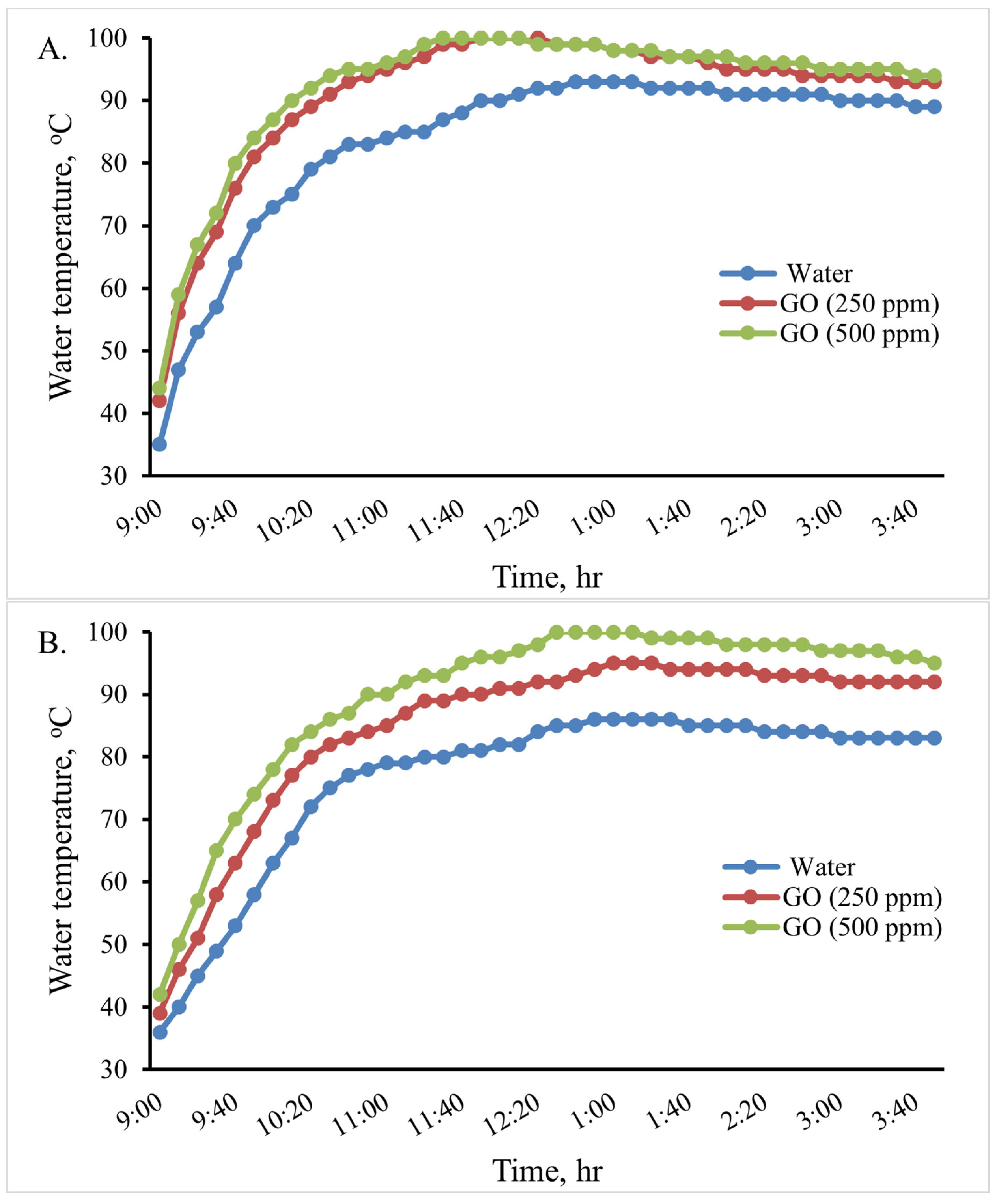

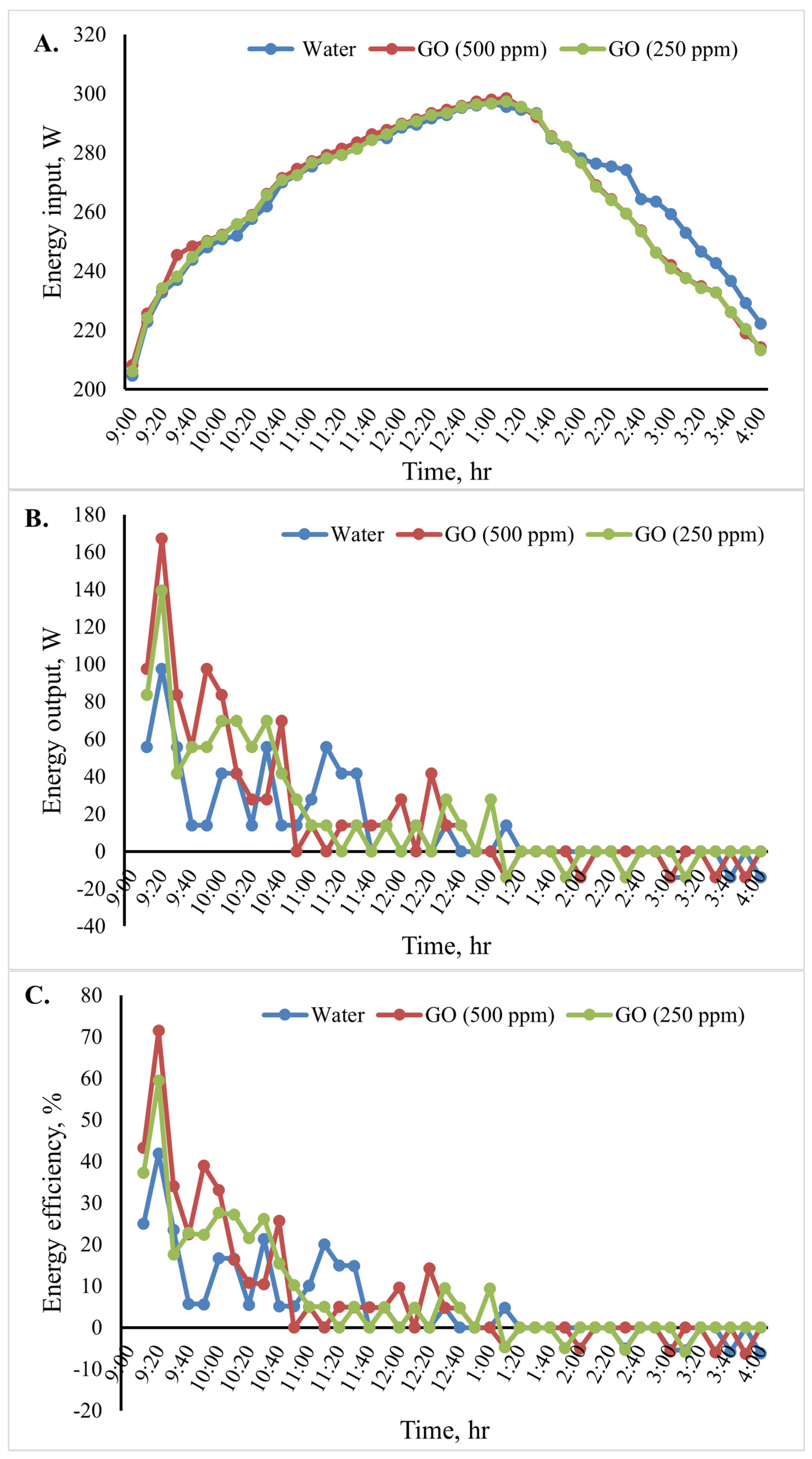


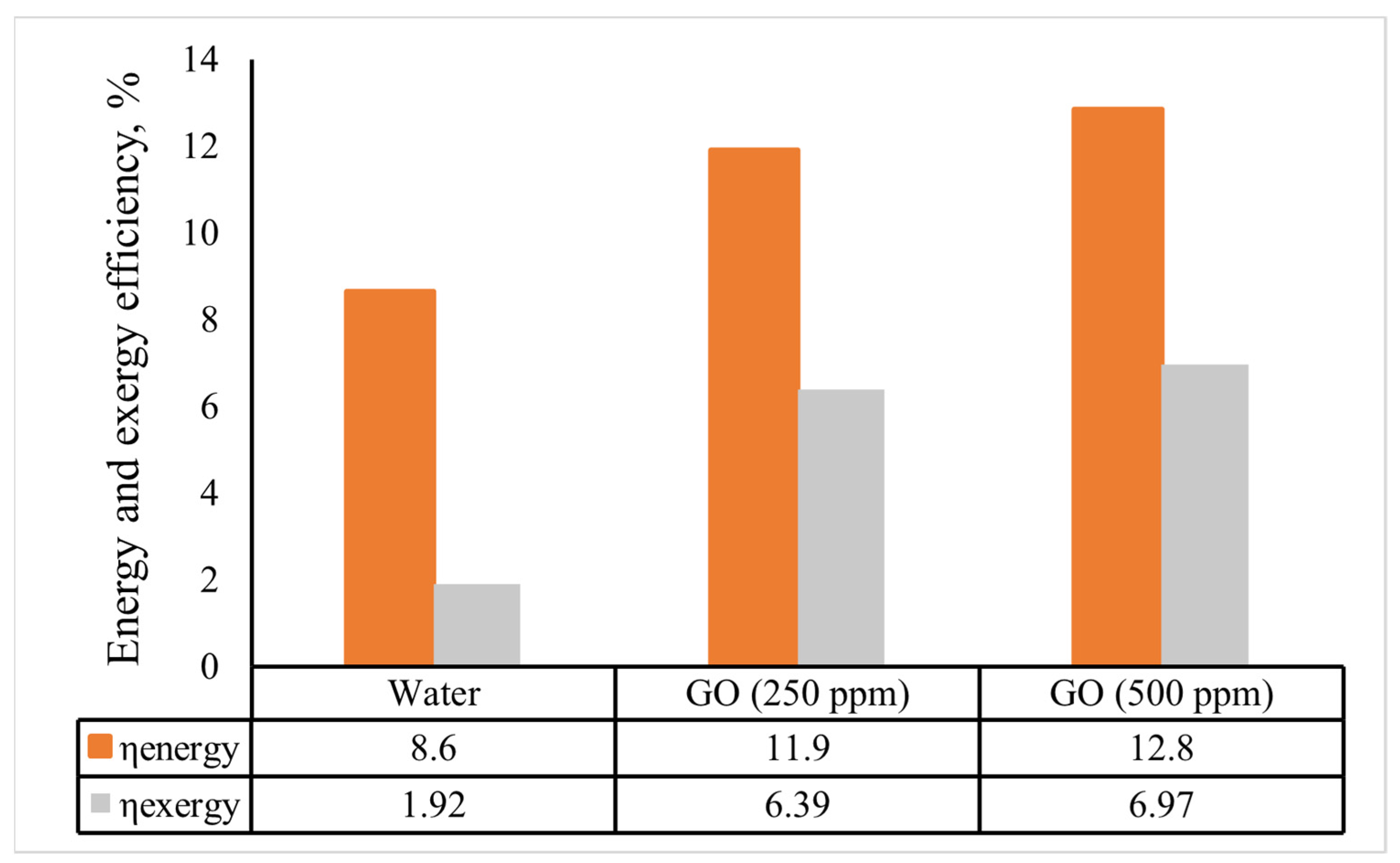
| Cp (J/kg·K) | ρ (kg/m3) | k (W/K·m) | |
|---|---|---|---|
| GO | 765 [35] | 3600 [35] | 3000 [35] |
| Water | 4180 | 998 | 0.598 |
| GO (250 ppm)-water | 4095 | 1063 | 0.644 |
| GO (500 ppm)-water | 4009 | 1128 | 0.692 |
| Parameter | Water | GO (250 ppm) | GO (500 ppm) |
|---|---|---|---|
| Solar radiation (I), W/m2 | 888.41 | 879.16 | 881.90 |
| Ambient temperature (Tamb), °C | 35.51 | 36.30 | 36.32 |
| Mass (g) | Time Required for Water to Reach 78 °C (min) | Cooking Time (min) | Number of Family Members |
|---|---|---|---|
| 200 | 60 | 25 | 2 children |
| 600 | 75 | 45 | 2 adults |
| 1000 | 95 | 70 | 2 adults + 4 children |
Disclaimer/Publisher’s Note: The statements, opinions and data contained in all publications are solely those of the individual author(s) and contributor(s) and not of MDPI and/or the editor(s). MDPI and/or the editor(s) disclaim responsibility for any injury to people or property resulting from any ideas, methods, instructions or products referred to in the content. |
© 2024 by the authors. Licensee MDPI, Basel, Switzerland. This article is an open access article distributed under the terms and conditions of the Creative Commons Attribution (CC BY) license (https://creativecommons.org/licenses/by/4.0/).
Share and Cite
Shaaban, F.M.; Abdel-Salam, M.F.; Farroh, K.Y.; Wang, H.; Atia, M.F. Thermal Performance Analysis of an Indirect Solar Cooker Using a Graphene Oxide Nanofluid. Sustainability 2024, 16, 2539. https://doi.org/10.3390/su16062539
Shaaban FM, Abdel-Salam MF, Farroh KY, Wang H, Atia MF. Thermal Performance Analysis of an Indirect Solar Cooker Using a Graphene Oxide Nanofluid. Sustainability. 2024; 16(6):2539. https://doi.org/10.3390/su16062539
Chicago/Turabian StyleShaaban, Fatma M., M. F. Abdel-Salam, Khaled Y. Farroh, Han Wang, and Mohamed F. Atia. 2024. "Thermal Performance Analysis of an Indirect Solar Cooker Using a Graphene Oxide Nanofluid" Sustainability 16, no. 6: 2539. https://doi.org/10.3390/su16062539






